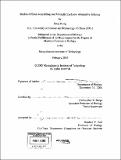| dc.contributor.advisor | Christopher B. Burge. | en_US |
| dc.contributor.author | Kong, Rong, 1979- | en_US |
| dc.contributor.other | Massachusetts Institute of Technology. Dept. of Biology. | en_US |
| dc.date.accessioned | 2005-09-27T19:10:18Z | |
| dc.date.available | 2005-09-27T19:10:18Z | |
| dc.date.copyright | 2005 | en_US |
| dc.date.issued | 2005 | en_US |
| dc.identifier.uri | http://hdl.handle.net/1721.1/28938 | |
| dc.description | Thesis (S.M.)--Massachusetts Institute of Technology, Dept. of Biology, 2005. | en_US |
| dc.description | Includes bibliographical references. | en_US |
| dc.description.abstract | The goals of this thesis work were to study two special alternative splicing events: exon scrambling at the RNA splicing level and mutually exclusive alternative splicing (MEAS) by computational and experimental methods. Chapter 1 presents work on the study of exon scrambling, in which exons are spliced at canonical splice sites but joined together in an order different from that predicated by the genomic sequence. The public expressed sequence tag (EST) database was searched for transcripts containing scrambled exons. Stringent criteria were used to exclude genome annotation or assembly artifacts. This search identified 172 human ESTs representing 90 exon scrambling events, which derive from 85 different human genes. In several cases, the scrambled transcripts were validated using an RT-PCR-sequencing protocol, confirming the reproducibility of these unusual events. Exon scrambling of transcripts from the GLI3 gene, which encodes a transcription factor involved in hedgehog signaling, was also conserved in mouse. Specific gene features, including the presence of long flanking introns were found to be associated with exon scrambling. Chapter 2 deals with mutually exclusive alternative splicing (MEAS), in which only one of a set of two or more exons in a gene is included in the final transcript. A database with 101 human genes and 25 mouse genes containing mutually exclusive exons (MXE) has been established with GENOA annotation software. Specific sequence features were analyzed. A genome-wide search for a special "tandem MEAS" events was undertaken and 10 such human genes were identified. A fluorescence reporting system was built to study intronic cis-elements regulating MEAS. | en_US |
| dc.description.statementofresponsibility | by Rong Kong. | en_US |
| dc.format.extent | 37, [16] leaves | en_US |
| dc.format.extent | 2017598 bytes | |
| dc.format.extent | 2022092 bytes | |
| dc.format.mimetype | application/pdf | |
| dc.format.mimetype | application/pdf | |
| dc.language.iso | en_US | |
| dc.publisher | Massachusetts Institute of Technology | en_US |
| dc.rights | M.I.T. theses are protected by copyright. They may be viewed from this source for any purpose, but reproduction or distribution in any format is prohibited without written permission. See provided URL for inquiries about permission. | en_US |
| dc.rights.uri | http://dspace.mit.edu/handle/1721.1/7582 | |
| dc.subject | Biology. | en_US |
| dc.title | Studies of exon scrambling and mutually exclusive alternative splicing | en_US |
| dc.type | Thesis | en_US |
| dc.description.degree | S.M. | en_US |
| dc.contributor.department | Massachusetts Institute of Technology. Department of Biology | |
| dc.identifier.oclc | 60552605 | en_US |
